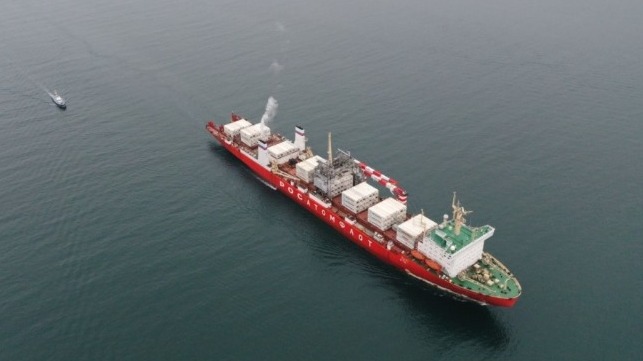Russia's Nuclear-Powered Cargo Ship Makes Late-Season Arctic Voyage

Russia is demonstrating its determination to open the Northern Sea Route (NSR) to shipping by dispatching the nuclear-powered cargo ship Sevmorput to deliver containers to Vladivostok, where the cargo will be transferred to a conventional vessel for onward transport to Bangladesh. This two-step route is 3,000 nm longer than using the Suez Canal to reach Bangladesh, but it will demonstrate the potential for unescorted, late-season navigation on the NSR.
On Tuesday, Sevmorput - the world’s last nuclear-powered cargo vessel - departed from the port of St. Petersburg, loaded with equipment and materials for construction of the Rooppur Nuclear Power Plant in Bangladesh.
State atomic energy corporation Rosatom said that Sevmorput’s voyage to the port of Vladivostok, which is expected to take 25 days, is bound to be grueling because of ice formation in the Arctic. “At present, an active process of ice formation is underway in the water area of the Northern Sea Route, but the technical characteristics of the vessel will allow it to pass the entire route without icebreaker assistance. The crew is ready for the task at hand,” said Mustafa Kashka, General Director of FSUE Atomflot.
At Vladivostok, about 1,400 tonnes of metal structures and equipment will be transloaded to another vessel for further transportation to the powerplant site near Dhaka, the capital of Bangladesh.
“The transport potential of our vessel is unique. We are . . . capable of taking on board oversized and heavy cargo, which allows us to reduce the number of vessels involved in sea transportation,” said Sergei Bralgin, Sevmorput's captain.
Russia believes that opening the Northern Sea Route offers strategic and economic importance as countries and shipping lines seek to find alternative routes to Asia and Europe. The blockage of the Suez Canal in March and the significant surge in global trade have highlighted the NSR's potential, according to Rosatom.
Rusatom Cargo, a subsidiary of Rosatom, believes that transit cargo flow along the Northern Sea Route can reach 80 million tons per year by 2024, up from 33 million last year.
The 61,000 dwt Sevmorput ("Northern Sea Route") entered service in 1988, in the twilight years of the Soviet Union. She was originally designed as a lighter aboard ship (LASH) barge carrier, and she is one of the last vessels with this capability remaining in service today. She was laid up in 2007 due to low demand for her services, but she was refitted and reactivated in 2015.
Sevmorput ran into trouble during her last sailing season. In October 2020, while attempting a record-setting voyage to deliver construction modules from Russia to Antarctica, she broke a propeller blade off the coast of Angola. Local officials refused to allow her into port for repairs. After a monthlong attempt to fix the propeller at sea, Rosatom ordered her to return to St. Petersburg. This year, she will remain close to Russian shores.
The ship is powered by a single KLT-40 nuclear reactor with a thermal output of 135 megawatts. When used as a boxship, she is able to carry 20- and 40-foot containers with a total capacity of 1,328 TEUs. In her long-disused LASH mode, she can carry 74 lighter barges; she is still fitted with the distinctive gantry crane and extended stern of a LASH carrier.
